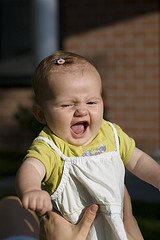Babies Sun Protection: Baby Sun Canopy, Babies Sunscreen and More
Your baby's skin is very thin and sensitive, so it doesn’t take long for baby to get sunburn. Should you consider a baby sun canopy or sun shade? What are the best babies sun lotion or babies sunscreen? These and more questions are answered here.
Protecting baby from the sun will have both long and short-term effects. Almost 80% of your child's lifetime sun exposure will occur during his first 20 years of life and UV radiation from the sun is the number one cause of skin cancers of all kind. Even if you’re not fair-haired, pale-skinned and freckled, the sun's burning rays are dangerous for everyone, but especially children.

The American Academy of Pediatrics used to recommend using no babies sunscreen for little ones under 6 months of age, however, due to the high risk of exposure, they have revised their recommendation to using small amounts of sunscreen on exposed areas such as the face and the back of hands. Your best bets are to keep baby covered in loose fitting clothes, provide shade for baby and use a minimal amount of sunscreen. For children over 6 months old, generously apply sunscreen. Expert Tip: Be careful around the eyes because getting sunscreen in the eyes is painful. If it happens, wash baby’s hands and eyes with a damp cloth. It’s best to use just water and not baby wipes that may have moisturizers or other irritants to baby’s eyes.
What's the best way to protect my baby and toddler in the sun?
These tips will set you in the right direction:
> Keep babies younger than 6 months out of direct sunlight. Find shade under a tree, baby sun canopy or an extended stroller canopy.
> Dress your child in clothes made with a tight weave - they protect better than clothes with a looser weave. Consider getting some clothing with special sun protection built in. Regular clothing does not offer much protection.
> To shield the face and neck, have your child wear a floppy hat.
> Limit your sun exposure between 10:00 am and 4:00 pm when UV rays are strongest.
> Have your child wear sunglasses with at least 99% UV protection. Baby’s eyes are particularly sensitive to the sun.
> Use babies sunscreen which is milder for the skin than adult sunscreen.
> Consider using a baby sun canopy, sun shade or sun tent. They are a great way to enjoy the outdoors while avoiding sun damage.
Which Sunscreen is Best for My Baby?
Use a babies sunscreen that says “broad-spectrum” on the label - that means it will screen out both UVB and UVA rays. The higher the SPF, the more protection from UVB rays. For kids, don’t use less than SPF 30. We also recommend choosing a sunscreen that is PABA free. It’s a common ingredient in sunscreens but has been associated with increased risk of skin cancer. You may prefer a waterproof type if baby will be in the water or sweating.
For areas of the body that are frequently exposed, such as the nose, cheeks, tops of the ears, and the shoulders, choose a sunscreen or sun block with zinc oxide or titanium dioxide. These products will remain visible on the skin even after you rub them in, some now come in fun colors that kids enjoy.
Applying Babies Sunscreen
These tips will help you get the most out of your sunscreen:
> Put sunscreen on 30 minutes before going outdoors. It needs time to absorb into the skin.
> Get in the routine of putting sunscreen on baby’s hands and face everyday.
> Use enough sunscreen to cover all exposed areas and rub it in well. Don’t forget the back of the knees.
> Use sunscreen any time your child might be in the sun. Baby’s skin is especially sensitive to sun exposure.
> Reapply babies sunscreen every 2 hours. Sunscreen wears off after swimming, sweating, or just from soaking into the skin.
Baby Has a Sunburn – What to Do?
First call the doctor. Sunburn in a child under age 1 can be more serious than it appears. Your baby's doctor may ask you to bring your baby in for an examination, to make sure that she doesn't need emergency treatment. Some symptoms, depending on the severity of the burn, include red skin, blisters, fever, dehydration and stomach upset.
> Give your baby plenty of fluids (breast milk or formula) to help her heal and replace fluids lost by being out in the sun.
>Soothe the sunburned area with a soft, wet washcloth. Gently place it on your baby's skin for ten to 15 minutes a few times a day.
> Your baby might like a cool bath. To make it more soothing, add baking soda. Pat your baby's skin dry.
> Apply a water-based (non-alcohol) moisturizing lotion or an aloe vera gel to relieve itching, which can get worse if the skin starts to peel.
> Ask your doctor if it's okay to give your baby the appropriate dose of children's ibuprofen or acetaminophen.
> Dress your baby in loose clothing that won't irritate his burned skin, and make sure you keep him out of the sun until his burn has completely healed, because it will be very easy for him to get a second burn now.
> Don't put petroleum jelly, butter or oil on your baby's skin. These prevent heat and sweat from escaping and can make a burn worse.
> Don't use first-aid sprays or ointments that contain benzocaine. They tend to irritate your baby's skin and can cause an allergic reaction.
Baby Safety Resources - Home Page



